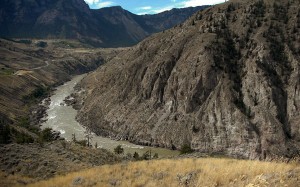Previous: The Evolution of Fairness
A little north of Lillooet the Fraser River narrows, forming a series of rapids that run between rocky shelves. Below each shelf is a quiet eddy, where the salmon rest before attempting to leap upstream. These shelves are known as fishing rocks, where the migrating fish can be efficiently harvested with dip nets, a simple technology that has changed little over thousands of years. The highly productive fishery found in this stretch of the canyon became the center of the ancient Lillooet culture.
The Fraser River cuts an impressive figure in southern British Columbia. (Photo by Alan Honick)

There are 22 fishing rocks along that stretch of the river. Access to them is obviously desirable, and some form of ownership that enables individuals or groups to control that access clearly confers an economic advantage. We spent three days in the area, hosted by Brian along with Suzanne Villeneuve, a colleague of Brian Hayden’s who has taken over active supervision of the research program.
We were also graciously hosted by members of the Stl’atl’imx First Nations, whose ancestors built these ancient villages. They continue to fish from the traditional rocks next to the eddies, catching and preserving salmon in much the same way as their ancestors. Chief Arthur Adolph of the Xaxli’p First Nation took us to a spectacular overlook on the cliffs above the river. In this video, Chief Adolph explains how they manage access to the resource today.



